Methods of Investigations of Books of Accounts & Other Documents
by Ram Dutt SharmaCONTENTS
| Chapter 1 Introduction | 1 |
| Loose-leaf Account Books | 2 |
| Preliminary decisions in questionnaire design | 2 |
| Deciding on the information required | 2 |
| Chapter 2 — Different Stages of Evolution of Money | � |
| Metallic Money | 8 |
| Paper Money | 8 |
| Credit Money | 8 |
| Electronic Money | 9 |
| Plastic Money | 9 |
| History of Indian Rupee | 9 |
| Chapter 3 — Maintenance of Books of Account by Certain Persons Engaged in Specified Professions or Businesses [Section 44AA] | 12 |
| Meaning of the Term “Books� | 12 |
| Preparation of Financial Statements | 13 |
| Voucher Maintenance and Supporting Documents | 13 |
| What are the Prescribed Books? | 14 |
| Who is required to maintain books of accounts? | 14 |
| Specified Professions | 15 |
| Non-Specified Professions | 15 |
| Business eligible for presumptive taxation scheme under Section 44AD, 44AE, 44BB, or 44BBB | 15 |
| Other Business | 16 |
| Which books of accounts are required to be maintained? | 16 |
| Where books of account and other documents should be kept and maintained? | 17 |
| Period of maintenance | 17 |
| Penalty for non-compliance [Section 271A] | 17 |
| Chapter 4 — Maintenance of Books of Account and other Documents by Persons Carrying on Certain Professions[Rule 6F of the Income Tax Rules, 1962] | 20 |
| Maintenance of Books of account and other documents by persons carrying on certain professions | 20 |
| Chapter 5 — Maintenance of Books of Account and other Documents by Trusts or Institution [Rule 17AA of the Income Tax Rules, 1962] | 23 |
| Books of Accounts and Other Documents required to be maintained | 29 |
| Mode in which Documents may be Kept | 30 |
| Consequences of failure to maintain | 32 |
| (i) Denial of Tax Exemption under sections 11 and 12: | 32 |
| (ii) Best Judgment Assessment under section 144: | 32 |
| (iii) Cancellation of Registration: | 32 |
| (iv) Penalty under Section 271AAD: | 32 |
| (v) Imprisonment under Section 276D: | 32 |
| Chapter 6 — Method of Accounting | 33 |
| What is Method of Accounting | 33 |
| Methods of Accounting Recognized | 34 |
| Apex Court’s Observation on recognized methods | 34 |
| Choice and Change in the Method of Accounting | 34 |
| Assessee has the choice on method, but such method should be shown as regularly followed | 35 |
| Benefits of Cash system | 36 |
| Chapter 7 — Defective, Duplicate or No Accounts Cases | 84 |
| Where does one find such cases? | 84 |
| No account case : Action points for Assessing Officer | 84 |
| Computation of profit in no account cases | 85 |
| Investment method or increase in capital method | 85 |
| Cash Flow and Investment | 88 |
| Estimation of Profit Method | 89 |
| Where Entire Unaccounted Sales are Treated as Income | 89 |
| Where Gross Profit is Estimated | 89 |
| Where Net Profit is Estimated | 90 |
| Peak Credit as an alternative to Estimation of Income | 91 |
| Double additions to be avoided: the investment and the source | 92 |
| Chapter 8 — Examination of Books of Account | 93 |
| Identification of books of account | 93 |
| Account books | 93 |
| Journal | 93 |
| Sales/Purchase Register | 94 |
| Identification of Debit and Credit Sides | 94 |
| Finding out Method of Accounting | 94 |
| Comparison with Back Records | 94 |
| Points which should be examined | 95 |
| Chapter 9 — Generating Undisclosed Income by Manipulation of Accounts | 96 |
| Manipulations of Accounts for Tax Evasion | 96 |
| (1) Out of Book Transactions | 96 |
| (2) Manipulation of Books of Account | 97 |
| (3) Under-reporting of Production | 99 |
| (4) Other Manipulations of Accounts | 99 |
| (5) Manipulation by way of International Transactions through Associate Enterprises | 99 |
| (6) Manipulation of Capital Expenses | 99 |
| Chapter 10 — Manipulation of Books of Accounts | 100 |
| In the Books of Accounts | 100 |
| Outside the Books of Accounts | 100 |
| Manifestation of Concealed Income/Unaccounted Funds | 100 |
| Qualities in order to achieve the best results | 100 |
| (a) Inflation of Purchases | 101 |
| (b) Suppression of Sale | 101 |
| (c) Inflation Cost of Production: | 101 |
| (d) Suppression of Production: | 102 |
| Manipulation of closing stock | 102 |
| Chapter 11 — Examination of Manufacturing Account | 103 |
| Inflation Cost of Production | 105 |
| Suppression of Production | 105 |
| Manufacturing expenses | 105 |
| Manufacturing Expenses and Direct Expenses | 105 |
| General particulars of Manufacturing Activity | 106 |
| Opening Stock | 107 |
| Purchases | 107 |
| Average Input | 107 |
| By raising bogus purchase bills | 109 |
| Manufacturing Expenses | 109 |
| Stores | 110 |
| Miscellaneous Expenses - repair expenses etc. | 111 |
| Production Records | 111 |
| Output ratio of main raw materials and main finished goods | 112 |
| Circumstances of sudden or violent fluctuation in prices | 112 |
| By-products of the production process | 112 |
| Analysis of input-output ratios and stock account | 113 |
| Whether the quantity of raw material consumed, is correctly reflected in the books of accounts or not ? | 113 |
| If the assessee is having a key-loan account | 114 |
| Minimum holding of raw materials | 114 |
| Examination of Stock Account where Driage is Claimed | 114 |
| Stock Tally Given by the Assessee | 115 |
| Chapter 12 — Examination of Trading Account | 117 |
| Disclosure requirements under AS - 17 | 117 |
| Method of constructing Quarterly trading account: | 120 |
| Manipulations in Trading Accounts | 121 |
| Chapter 13 — Examination of Profit & Loss account | 123 |
| Format of Profit and Loss Account | 123 |
| Credit side of Profit and Loss or Income & Expenditure Account : | 124 |
| Common issues involved while examining the Profit and Loss account | 125 |
| [i] Whether any capital expenditure is debited as revenue | 125 |
| [ii] Whether any personal expenditure is debited in the guise of business expenditure | 125 |
| [iii] Whether any expenditure incurred for any purpose which is an offence or which is prohibited by law; | 125 |
| Points for verification of various items of expenses in the Profit and Loss Account | 126 |
| Sales promotion/commission | 128 |
| Chapter 14 — Examination of Genuineness of Vouchers | 135 |
| Chapter 15 — Inflation of Expenses | 136 |
| Illustration (Bogus Purchases) | 136 |
| Chapter 16 — Verification of Gross Profit Rate (GP Rate) | 137 |
| Periodical Analysis of Purchase/Sales: | 139 |
| Common defects in Books | 140 |
| Estimating Fair G.P. Rate | 140 |
| To verify steep fall in Gross Profit rate | 141 |
| Chapter 17 — Net Profit Rate | 146 |
| Chapter 18 — Examination of Balance Sheet | 156 |
| Limitations of Balance Sheet | 156 |
| About Balance sheet | 157 |
| Non-Moving Debtors/Creditors | 159 |
| Preliminaries of Enquiry | 159 |
| Balance Sheet for the first year | 160 |
| Action point for Assessing Officer | 160 |
| Chapter 19 — Examination of Statement of Assets and Liabilities | 165 |
| (a) To compare the increase in assets with admitted income | 165 |
| (b) To detect bogus liabilities | 165 |
| (c) To detect under-valuation of assets | 166 |
| (d) To make assessee commit with regard to his capital, drawings, etc: | 166 |
| Chapter 20 — Share Capital | 167 |
| Share capital in light of section 68 of the Income-tax Act, 1961 | 167 |
| Routing unaccounted money using listed paper companies,‘colorable device’ & fraud on Revenue | 167 |
| Chapter 21 — Share Application Money | 177 |
| Share application money pending for allotment of shares | 177 |
| Checklist for Verification | 177 |
| Chapter 22 — Share Premium in Excess of Fair Market Value to be Taxed as Income [Section 56(2)(viib)] | 191 |
| Share premium in excess of the fair market value deemed as income [Section 56(2)(viib)] | 191 |
| Background | 191 |
| Objective of the amendment to section 56(2)(viib) | 192 |
| Extract of object Memorandum of Finance Bill, 2012 | 192 |
| Position after 31.03.2012 | 193 |
| Applicability of clause (viib) to section 56(2) | 195 |
| Extension of exemption to Categories I & II AIF [clause (i) of Section 56(2)(viib) of the Income-tax Act, 1961 – Income from other sources — chargeable as — Start ups — Clarification with respect to assessment of startup companies involving application of said section of the Income-tax Act, 1961 | 212 |
| Notified class of persons under clause (ii) of proviso to Section 56(2)(viib) | 213 |
| Notification No. SO 1131(E), dated 05.03.2019 | 213 |
| Chapter 23 — Sundry Debtors (Trade) | 241 |
| Sundry Debtors (Receivables) | 241 |
| Investigations of Sundry Debtors, Loans and Advances | 242 |
| Sundry (trade) debtors is more than sales | 242 |
| Trade debtors’ balances remaining constant | 243 |
| Chapter 24 — Sundry Creditors (Trade) | 244 |
| Action point for Assessing Officer | 244 |
| Trade creditors’ balances remaining constant | 244 |
| When trade creditors finance/source fixed assets | 245 |
| Total purchases is less than Sundry (trade) Creditors | 245 |
| Chapter 25 — Loans, Advances and Deposits | 246 |
| Action points for Assessing Officer | 246 |
| Chapter 26 — Reserve & Surplus | 247 |
| Types of Reserves and Surplus | 247 |
| Share Premium Account | 247 |
| Sinking Fund: | 248 |
| Taxation Reserves | 248 |
| Subsidy Reserve | 248 |
| Revaluation Reserve | 248 |
| Debenture Redemption Reserve (DRR) | 248 |
| Examining Reserves | 248 |
| Origin of reserves should be examined | 249 |
| Action points for Assessing Officer | 249 |
| Chapter 27 — Secured Loans | 250 |
| Loans and Advances from Banks | 250 |
| Bank Loan | 250 |
| Action points for Assessing Officer | 251 |
| Chapter 28 — Unsecured Loans | 252 |
| All new cash credits should be examined | 252 |
| Loan Creditors: | 252 |
| Cash Credits/Benami Transactions | 253 |
| Action points for Assessing Officer | 253 |
| Chapter 29 — Investment | 255 |
| Action point for Assessing Officer | 255 |
| Disclosure Requirements: | 255 |
| Revaluation of Long Term Investments | 256 |
| Income from Investments: | 256 |
| Chapter 30 — Fixed Assets | 257 |
| Action point for Assessing Officer | 257 |
| Tangible Fixed Assets | 257 |
| Intangible Fixed Assets | 258 |
| Addition to Fixed Assets | 259 |
| Reduction in Fixed Assets: | 259 |
| Amalgamation/Merger/De-merger | 259 |
| De-merger | 259 |
| Capital Expenditure v. Revenue Expenditure | 259 |
| Capital Work-in-Process (CWIP) | 260 |
| Chapter 31 — Depreciation | 261 |
| Written Down Value of block of assets | 262 |
| Mis-use of Depreciation Provisions | 262 |
| Multiple Financing | 262 |
| Existence/Genuineness of Depreciable Assets on which Higher Rate of Depreciation is Allowed: | 262 |
| Excess Claim of Depreciation | 262 |
| Multiple Dip | 263 |
| Off-Balance Sheet Fixed Assets | 263 |
| Chapter 32 — Liabilities | 264 |
| Capital Structure of Companies | 264 |
| Types of Shares: | 264 |
| Altering Share Capital | 264 |
| Bonus Shares: | 265 |
| Share Application Moneys | 265 |
| Redemption of Redeemable Preference Shares | 265 |
| Conversions | 265 |
| Conversion of Partnerships into Companies | 265 |
| New Share Capital: | 265 |
| Shares-in-kind | 266 |
| New Financial Instruments—Deferred Capital | 266 |
| Capital introduction—Section 68 | 267 |
| Building Capital through Circular Transactions | 267 |
| Introduction of Share Capital through Bogus/Paper Companies | 267 |
| Perpetual Non-Convertible Debentures (“PNCDs�) or Hybrid Bonds | 267 |
| Remission of liability | 268 |
| Chapter 33 — Current Liabilities | 269 |
| Acceptance | 269 |
| Sundry Creditors | 269 |
| Advance Payments and Unexplored Discount | 269 |
| Unclaimed Dividend | 269 |
| Chapter 34 — Contingent Liabilities | 270 |
| Provision for various contingent liabilities | 270 |
| Liability in respect of provision for warranty claims is not a contingent liability | 270 |
| Liability of Contingent nature - The present value of contingent liability, like warranty expense, if properly ascertained & discounted on accrual basis is allowable | 270 |
| Chapter 35 — Provisions | 274 |
| Provision for Taxation | 274 |
| Provision for Provident Fund and other Retirement Benefits | 274 |
| Provision for Contingencies | 274 |
| Provision for Loss in the Value of Investments | 274 |
| Action points for Assessing Officer | 274 |
| Chapter 36 — Examination of Cash Book | 275 |
| Format of Double Column Cash/Bank Book | 275 |
| What to examine in a Cash Book ? | 275 |
| [1] Cash credits | 276 |
| [2] Entries at the end of cash book | 276 |
| [3] Unledgerised entries | 276 |
| [4] Daily balancing of cash book | 276 |
| [5] Opening entries | 277 |
| [6] Cash credit and bogus sales | 277 |
| [7] Ante dating of receipts | 277 |
| [8] Cash Payments Exceeding 10,000/- (i.e., Section 40A(3) payments) | 277 |
| [9] Minimum, Maximum and Average Cash Balance | 277 |
| [10] Summary of all the Cash Payments | 278 |
| Daily balancing of cash book | 278 |
| Opening entries | 278 |
| Postponing entry of Cash deposited in the Bank | 278 |
| Inflating Receipt Side Total and Deflating Payment Side Total in Cash Book | 279 |
| Postponing Entry of Cash Deposited in the Bank | 279 |
| Chapter 37 — Negative Cash Balance | 280 |
| Chapter 38 — Examination of Day Book | 282 |
| Chapter 39 — Contra Entry | 283 |
| Chapter 40 — Cash in Hand | 284 |
| If cash on hand is less than cash balance as per cash book | 284 |
| Deficit cash and deficit stock | 284 |
| Deficit cash and no difference in stock | 284 |
| Conclusion on deficit cash: | 284 |
| Chapter 41 — Examination of Cash Flow Statement | 285 |
| Uses of Cash Flow Statement | 286 |
| Examination of Cash Flow Statement | 286 |
| Chapter 42 — Funds Flow Statement | 288 |
| Uses of Funds Flow Statement | 288 |
| Chapter 43 — Examination of Ledger | 289 |
| Format of Ledger Account | 289 |
| How to examine a ledger? | 289 |
| Bank A/c in the ledger should be compared with bank pass book | 290 |
| Chapter 44 — Verification of squared up accounts during the year | 291 |
| Verification of squared up accounts | 291 |
| Cash Credits/Benami Transactions | 291 |
| Chapter 45 — Trial Balance | 293 |
| Meaning & Definition of Trial Balance: | 293 |
| Action point for Assessing Officer | 293 |
| Chapter 46 — Examination of Journal | 294 |
| Points to look for in journals | 294 |
| Chapter 47 — Opening Stock & Closing Stock | 295 |
| Type of inventory | 295 |
| Action point for Assessing Officer | 295 |
| When inventory is produced | 295 |
| When inventory is not produced | 296 |
| Chapter 48 — Closing Stock | 304 |
| Closing stock can also be checked with reference to availability of storage space | 307 |
| Suppression of Closing Stock | 308 |
| Goods in Transit and Paid for: | 308 |
| Goods Sent to Customers for Approval: | 308 |
| Closing Stock at Branches: | 308 |
| Under-valuation of Closing Stock: | 308 |
| Overstatement of Closing Stock | 309 |
| Quantitative Details - Stock Register | 309 |
| Valuation of Inventories: | 310 |
| Important Points Regarding Valuation of Stocks | 310 |
| If actual quantity of physical stock is more than stock as per books | 311 |
| If actual quantity of physical stock is less than stock as per books | 313 |
| If actual value of physical stock is in excess of value as per books: | 313 |
| If actual value of physical stock is less than value as per books | 314 |
| Verification of correctness of closing stock value admitted in the return | 314 |
| Steep fall in closing stock value | 315 |
| Stock is equal to or at least 50% of turnover | 315 |
| Chapter 49— Verification of Purchases | 316 |
| Beneficiaries of bogus entry providers | 316 |
| Verification of Purchase Vouchers | 317 |
| Verification with Suppliers | 318 |
| Verification of Mode of Payment | 318 |
| Inflation of purchase | 318 |
| Post-dated Purchases and Expenses | 320 |
| Showing Cash Purchases as Credit Purchases | 320 |
| [1] Bogus Purchases | 321 |
| [2] Over Invoicing | 321 |
| [3] Over-Invoicing of Imports | 321 |
| [4] Earlier/Later Purchases Recorded | 322 |
| [5] Purchase of Inferior Quality Recording Superior Goods: | 322 |
| [6] Purchases Recorded at High Price Zone: | 322 |
| [7] Purchasing Non-Saleable Goods as Standard Goods and Subsequently Writing Off of Stock as Bad/Unsaleable, etc. | 322 |
| [8] Not Accounting Purchase Return: | 322 |
| [9] Miscellaneous Matters | 323 |
| Methods employed for inflating purchases | 323 |
| Inflation of Purchases | 323 |
| Purchases should also be checked with reference to direct expenses 324 | |
| Chapter 50 — Fictitious purchases | 326 |
| Action points for Assessing Officer | 326 |
| When an Assessing Officer is likely to find out about bogus transactions? | 326 |
| Linking of fictitious transactions | 327 |
| Chapter 51 — Bogus Purchases | 329 |
| Some common methods of introducing bogus purchases | 329 |
| Type of additions seen made in different cases of assessee | 331 |
| Chapter 52 —Verification of Sales | 355 |
| Enquiries from assessee | 355 |
| Action points for Assessing Officer | 356 |
| 1. Sales Outside the Books: | 357 |
| 2. Under Invoicing: | 357 |
| 3. Excluding the Sales at the Beginning/End of the Year | 357 |
| 4. Sale of Quality Goods Shown as Sale of Sub-Standard Goods | 358 |
| 5. Sales Pushed to Low Price Zone: | 358 |
| 6. Sales Return: | 358 |
| Mode of Payment | 358 |
| Sales at Lower Rates to Nominees | 358 |
| Miscellaneous | 359 |
| Verification with Contract Notes | 359 |
| Suppression of Sale | 360 |
| Where Entire Unaccounted Sales are Treated as Income | 360 |
| Chapter 53 — Understatement of Sales by Suppression | 361 |
| Chapter 54 — Fictitious Sales | 363 |
| Sales to a Fictitious and Non-Existent Concern | 363 |
| Chapter 55 — Treatment of Cash Sales | 365 |
| No law which prohibits a trader or a manufacturer in making cash sales | 365 |
| Showing Fictitious Cash Sales or Speculation Profits | 365 |
| Cash credit and bogus sales | 365 |
| Showing Fictitious Cash Sales or Speculation Profits | 365 |
| Cash Sale – Tax provisions | 366 |
| Non-Applicability of section 269ST | 366 |
| Penalty | 367 |
| CBDT Circular No. 27/2017, Dated 03.11.2017 | 367 |
| Chapter 56 — Unaccounted Purchases & Sales | 371 |
| Chapter 57 — Trade/Cash Discounts | 376 |
| Comparison between trade discount and cash discount | 376 |
| CBDT Circular No. 12 of 2022, Dated 16.06.2022 | 376 |
| Chapter 58 — Consignment Account Meaning of Consignment Account | 378 |
| Account for goods that is sent to a person or company that is not the owner but is responsible for selling them or returning them to the owner if they are not sold: The value of the goods that are sent on consignment are charged to the consignment account | 378 |
| Accounting of Consignment Sale | 379 |
| Consignment Sale in Pre-GST Period | 380 |
| Consignment Sale under GST Regime | 380 |
| Points for Verification | 381 |
| Chapter 59 — Bogus Capital Gains from Penny Stocks | 384 |
| What are penny stocks? | 384 |
| Background | 384 |
| Results of Kolkata Investigations [Investigation Report of the Directorate of Income Tax (Investigation) Kolkata, in case of Project Bogus LTCG through BSE Listed Penny Stocks] | 385 |
| SEBI Investigation and ban | 385 |
| Types of penny stock companies | 386 |
| Method of Transaction | 386 |
| 1. Conventional method | 386 |
| 2. Merger method | 386 |
| Modus operandi as per Investigation report | 387 |
| Entities involved in the transactions | 389 |
| Bogus capital gains from Penny stocks | 390 |
| Assessee needs to maintain and produce following documents/evidence to prove the genuineness of the share transaction | 390 |
| Basic Documents | 390 |
| Action Point for Assessing Officer: | 391 |
| Gathering the information available in public domain: | 392 |
| Information to be collected from assessee: | 392 |
| Information to be gathered from other sources: | 393 |
| Collect all the informations and summoning the Assessee | 394 |
| Specimen of Summons under Section 131 | 395 |
| Tax Rates [As per Section 115BBE] | 396 |
| Standard Operating Procedure (SOP) issued by the Department to Handle Cases of Bogus Long-term Capital Gain/Loss Mainly Penny Stock | 397 |
| Steps taken by the Government | 397 |
| Chapter 60 — Investigation of Bank Accounts | 424 |
| Records kept by Banks | 424 |
| Account Opening Forms | 424 |
| Locker Register | 425 |
| Fixed Deposit Register | 425 |
| Clearing Register | 425 |
| OBC Register | 425 |
| Slip Bundles | 425 |
| Types of Bank Accounts | 425 |
| Saving Bank Accounts: | 425 |
| Current Accounts: | 425 |
| Cash Credit Accounts: | 426 |
| Fixed Deposit Accounts: | 426 |
| Deposits in Bank Accounts | 426 |
| Withdrawals from bank accounts | 427 |
| Types of Cheques: | 427 |
| Follow-up of Cheques | 430 |
| Introduction of unaccounted cash as Cash Credit | 432 |
| Debit on Account of Bank Charges | 433 |
| Other Similar Clues | 433 |
| Tracing of Secret Bank Accounts | 434 |
| Remittances of secret T.T./D.D. in Benami Names | 434 |
| Discounting of Bills | 435 |
| Analysis of Foreign Exchange Transactions | 435 |
| Verification of Credit Card Slips | 436 |
| Tax Evasion using Networked Systems of Banking | 436 |
| Bank balance: | 437 |
| Chapter 61 — Examination of Bank statement | 438 |
| Action points for Assessing Officer | 438 |
| Chapter 62 — Cash Deposits found in Banks | 440 |
| Consequences if any money found deposited in bank statements for which no valid explanation about the nature and source of the cash, or if the assessing officer is not satisfied with the explanation provided | 440 |
| (i) Imposition of tax under section 115BBE | 440 |
| (ii) Penalty under section 271AAC | 440 |
| (iii) Penalty under section 270A [For other additions, i.e., other than additions made under sections 68 to 69D] | 441 |
| Cash in hand- Test to be satisfied | 441 |
| Cash Sale – Tax provisions | 441 |
| Chapter 63 — Deposit Found in Foreign Bank Account | 479 |
| Chapter 64 – Drawings | 484 |
| Action points for Assessing Officer | 484 |
| Chapter 65 — Peak Credit Theory | 485 |
| Theory of Peak Credit | 485 |
| Chapter 66 — Theory of Telescoping in Determining the Taxability of Undisclosed Income | 490 |
| What is theory of Telescoping | 490 |
| Telescoping | 490 |
| Brief background of Telescoping | 491 |
| Manner of application of the theory of telescoping | 492 |
| Chapter 67 — Surrounding Circumstances and Test of Applying Human Probabilities | 507 |
| Suspicious and dubious transaction how to be dealt with | 507 |
| Circumstantial evidence how to be used | 507 |
| Surrounding circumstances and test of applying human probabilities | 508 |
| Chapter 68 — Ratio Analysis | 525 |
| Step 1 | 525 |
| Step 2 | 525 |
| Step 3 | 525 |
| Step 4 | 525 |
| Major Reasons of Deviations | 525 |
| [1] Acid Test or Quick Ratio: | 526 |
| [2] Stock Turnover Ratio: | 526 |
| [3] Debtor’s Turnover Ratio: | 526 |
| [4] Creditor’s Turnover Ratio: | 527 |
| [5] Debt Capital Ratio: | 527 |
| [6] Gross Profit Ratio: | 527 |
| [8] Expenses Ratio: | 528 |
About the Author
Ram Dutt Sharma
Ram Dutt Sharma was born on 27th June, 1958 in Narnaul, Haryana. He got his post-graduation from M.D. University, Rohtak in 1980. He joined the Income-tax Department in the year 1983 and retired as Income Tax Officer on 30.06.2018. He worked at various stations of North-West Region of Income-tax Department. He has wide experience of all wings of Income-tax Department such as Assessment Unit, Special Range, TDS Wing, Investigation Wing, etc. He has been Contributing articles and addressing on topics relating to Income Tax at NADT Regional Campus, Chandigarh & Bhopal. He has also addressed number of seminars organized by the Income-tax Department, Chartered Accountants, Advocates and various Trade Associations.
He is recipient of first-ever Finance Minister's Award 2017, the Income Tax Departments highest honour for sustained devotion, commitment to duty & promoting excellence in the field of Direct Taxation at National Level. The Hon'ble Union Finance Minister, Shri ArunJaitley conferred this Finance Ministers Award for Excellence for his meritorious services at VigyanBhawan, New Delhi on 24.07.2017.
Awarded by Hon'ble Member (Revenue& TPS), CBT, Special Secretary to the Government of India Certificate of Appreciation for his contribution recognized and included in the chapter Miscellaneous Orders in Let Us Share A compilation of Best Practices & Orders Vol. VIII released on 31stOctober, 2016.
Have Questions About This Book?
Our course advisors are here to help you make the right decision for your career growth.
Other books
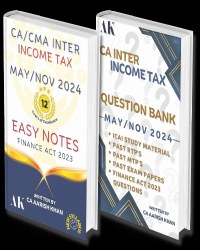
CA/CMA INTER COMBO - COLOURED EASY NOTES + QUESTION BANK
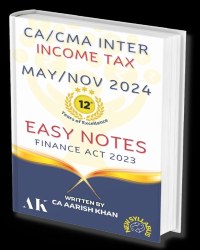
CA/CMA INTER EASY NOTES COLOURED
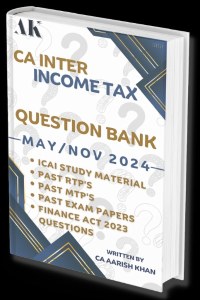
CA/CMA INTER INCOME TAX QUESTION BANK

GST (IDT) Book - 4th Edition | May, Sept 2026 & Jan 2027 Attempt
List your Books
Share your knowledge and help shape the next generation of tech-savvy CA & Tax professionals while building a rewarding career in education.
Get Started

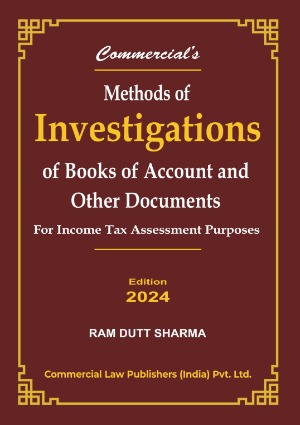
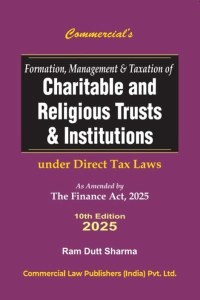
 CAclubindia
CAclubindia
